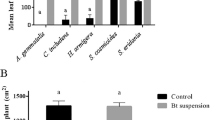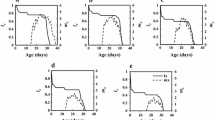Abstract
The bacterium Bacillus thuringiensis (Bt) Berliner and the braconid wasp Habrobracon hebetor Say are valuable biocontrol agents attacking larval stages of Helicoverpa armigera (Hübner). Little information is available regarding combination of these biocontrol agents during integrated management of H. armigera. To address this knowledge gap, we document sublethal effects of Bacillus thuringiensis var. kurstaki (Btk) on the H. hebetor attacking H. armigera larvae infected with Btk. The results revealed that the duration of different life stages and fecundity of H. hebetor was significantly affected by sublethal treatments with Btk. We also present data supporting that sublethal concentrations of Btk could adversely affect life table parameters of H. hebetor. Sublethal treatments reduced the net reproductive rate (R 0) and there were also significant differences among the values of this parameter at all treatments tested. The intrinsic (r m ) and finite (λ) rates of increase were also significantly lower in parasitoid wasps reared on the treated larvae of H. armigera compared to control. These findings will be useful to develop appropriate strategies for assessing the risks of Btk to the parasitoids and safe deployment of both organisms in integrated pest management programs for sustainable crop production.


Similar content being viewed by others
References
Baur ME, Boethel DJ (2003) Effect of Bt-cotton expressing Cry1A(c) on the survival and fecundity of two hymenopteran parasitoids (Braconidae, Encyrtidae) in the laboratory. Biol Control 26:325–332
Bernal JS, Griset JG, Gillogly PO (2002) Impacts of developing on Bt maize-intoxicated hosts on fitness parameter of a stem borer parasitoid. J Entomol Sci 37:27–40
Blumberg D, Navon A, Keren S, Goldenberg S, Ferkovich SM (1997) Interactions among Helicoverpa armigera (Lepidoptera: Noctuidae), its larval endoparasitoid Microplitis croceipes (Hymenoptera: Braconidae), and Bacillus thuringiensis. J Econ Entomol 90:1181–1186
Carey JR (1993) Applied demography for biologists, with special emphasis on insects. Oxford University Press, Oxford, UK
Desneux N, Decourtye A, Delpuech JM (2007) The sublethal effects of pesticides on beneficial arthropods. Annu Rev Entomol 52:81–106
Dulmage H, Dulmage HT, Boening OP, Rehnborg CS, Hansen GD (1971) A proposed standardized bioassay for formulations of Bacillus thuringiensis based on the international unit. J Invertebr Pathol 18:240–245
El-Maghraby MMA, Hegab A, Yousif-Khalil SI (1988) Interactions between Bacillus thuringiensis Berl., Beauveria bassiana (Basl.) Vuill. and host/parasitoid system Spodoptera littoralis (Boisd.)/Microplitis rufiventris Kok. J Appl Entomol 106:417–421
Erb SL, Bourchier RS, van Frankenhuyzen K, Smith SM (2001) Sublethal effects of Bacillus thuringiensis Berliner subsp. kurstaki on Lymantria dispar (Lepidoptera: Lymantriidae) and the tachinid parasitoid Compsilura concinnata (Diptera: Tachinidae). Environ Entomol 30:1174–1181
Fathipour Y, Naseri B (2011) Soybean cultivars affecting performance of Helicoverpa armigera (Lepidoptera: Noctuidae). In: Ng TB (ed) Soybean-biochemistry, chemistry and physiology. InTech, Rijeka, Croatia, pp 599–630
Fathipour Y, Sedaratian A (2013) Integrated management of Helicoverpa armigera in soybean cropping systems. In: El-Shemy H (ed) Soybean—pest resistance. InTech, Rijeka, Croatia, pp 231–280
Flexner JL, Lighthart B, Croft BA (1986) The effects of microbial insecticides on non-target beneficial arthropods. Agr Ecosyst Environ 16:203–254
Godfray HCJ (1994) Parasitoids. Princeton University Press, Princeton, USA
Hamedi N, Fathipour Y, Saber M (2009) Sublethal effects of fenpyroximate on life table parameters of the predatory mite Phytoseius plumifer. BioControl 55:271–278
Mahdavi V, Saber M, Rafiee-Dastjerdi H, Mehrvar A (2011) Comparative study of the population level effects of carbaryl and abamectin on larval ectoparasitoid Habrobracon hebetor Say (Hymenoptera: Braconidae). BioControl 56:823–830
Mahdavi V, Saber M, Rafiee-Dastjerdi H, Mehrvar A (2013) Susceptibility of the hymenopteran parasitoid, Habrobracon hebetor (Say) (Braconidae) to the entomopathogenic fungi Beauveria bassiana Vuillemin and Metarhizium anisopliae Sorokin. Jordan J Biol Sci 6:17–20
Maia AHN, Luiz AJB, Campanhola C (2000) Statistical inference on associated fertility life table parameters using jackknife technique: computational aspects. J Econ Entomol 93:511–518
Mbata GN, Shapiro-Ilan DI (2010) Compatibility of Heterorhabditis indica (Rhabditida: Heterorhabditidae) and Habrobracon hebetor (Hymenoptera: Braconidae) for biological control of Plodia interpunctella (Lepidoptera: Pyralidae). Biol Control 54:75–82
Mohan M, Sushil SN, Bhatt JC, Gujar GT, Gupta HS (2008) Synergistic interaction between sublethal doses of Bacillus thuringiensis and Campoletis chlorideae in managing Helicoverpa armigera. BioControl 53:375–386
Murugan K, Senthil KN, Jeyabalan D, Senthil NS, Sivaramakrishnan S, Swamiappan M (2000) Influence of Helicoverpa armigera (Hübner) diet on its parasitoid Campoletis chlorideae Uchida. Insect Sci Appl 20:23–31
Oluwafemi AR, Raol Q, Wang XQ, Zhang HY (2009) Effect of Bacillus thuringiensis on Habrobracon hebetor during combined biological control of Plodia interpunctella. Insect Sci 16:409–416
Pedersen A, Dedes J, Gauthier D, van Frankenhuyzen K (1997) Sublethal effects of Bacillus thuringiensis on the spruce budworm, Choristoneura fumiferana. Entomol Exp Appl 83:253–262
Romeis J, Meissle M, Bigler F (2006) Transgenic crops expressing Bacillus thuringiensis toxins and biological control. Nat Biotechnol 24:63–71
Rosner B (2000) Fundamentals of biostatistics. Duxbury Press, Pacific Grove, USA
Salama HS, Zaki FN, Sabbour MM (1996) Effect of Bacillus thuringiensis endotoxin on Apanteles litae Nixon and Bracon instabilis Marsh (Hym., Braconidae), two parasitoids of the potato tuber moth Phthorimia operculella Zeller (Lep., Gelishiidae). J Appl Entomol 120:565–568
Sanders CJ, Pell JK, Poppy GM, Raybould A, Garcia-Alonso M, Schuler TH (2007) Host-plant mediated effects of transgenic maize on the insect parasitoid Campoletis sonorensis (Hymenoptera: Ichneumonidae). Biol Control 40:362–369
SAS (2003) A guide to statistical and data analysis, version 9.1. SAS Institute, Cary, USA
Sayyed AH, Wright DJ (2002) Genetic diversity of Bt resistance: implications for resistance management. Pakistan J Biol Sci 5:1330–1344
Sedaratian A, Fathipour Y, Talaei-Hassanloui R, Jurat-Fuentes JL (2013) Fitness costs of sublethal exposure to Bacillus thuringiensis in Helicoverpa armigera: a carryover study on offspring. J Appl Entomol 137:540–549
Sharma HC, Dhillon MK, Arora R (2008) Effects of Bacillus thuringiensis δ-endotoxin-fed Helicoverpa armigera on the survival and development of the parasitoid Campoletis chlorideae. Entomol Exp Appl 126:1–8
Shorey HH, Hale RL (1965) Mass-rearing of the larvae of nine noctuid species on a simple artificial medium. J Econ Entomol 58:522–524
Singh SP, Ballal CR, Poorani J (2002) Old world bollworm Helicoverpa armigera, associated Heliothinae and their natural enemies. Project Directorate of Biological Control, Bangalore, India
SPSS (2004) SPSS base 13.0 user’s guide. SPSS, Chicago, USA
Stoianova EE (2007) The effect of the Nuclear Polyhedrosis Viruses (NPVs) of some noctuidae species on the longevity of Bracon hebetor Say (Hymenoptera: Braconidae). Bulg J Agric Sci 13:197–203
Taylor AD (1988) Host effects on larval competition in the gregarious parasitoid Bracon hebetor. J Anim Ecol 57:163–172
Teera-Arunsiri A, Suphantharika M, Ketunuti U (2003) Preparation of spray-dried wettable powder formulations of Bacillus thuringiensis-based biopesticides. J Econ Entomol 96:292–299
Walker GP, Cameron PJ, MacDonald FM, Madhusudhan VV, Wallace AR (2007) Impacts of Bacillus thuringiensis toxins on parasitoids (Hymenoptera: Braconidae) of Spodoptera litura and Helicoverpa armigera (Lepidoptera: Noctuidae). Biol Control 40:142–151
Wallner WE, Dubois NR, Grinberg PS (1983) Alteration of parasitism by Rogas lymantriae (Hymenoptera: Braconidae) in Bacillus thuringiensis-stressed gypsy moth (Lepidoptera: Lymantriidae) hosts. J Econ Entomol 76:275–277
Acknowledgments
This work is a part of the Ph.D. dissertation of the first author, which financially supported by Tarbiat Modares University. The authors are grateful to Vida Sadraeian for her assistance in laboratory experiments. We also thank Juan Luis Jurat-Fuentes at The University of Tennessee for his thoughtful comments on earlier version of the manuscript.
Author information
Authors and Affiliations
Corresponding author
Additional information
Handling Editor: Helen Roy.
Rights and permissions
About this article
Cite this article
Sedaratian, A., Fathipour, Y. & Talaei-Hassanloui, R. Deleterious effects of Bacillus thuringiensis on biological parameters of Habrobracon hebetor parasitizing Helicoverpa armigera . BioControl 59, 89–98 (2014). https://doi.org/10.1007/s10526-013-9531-1
Received:
Accepted:
Published:
Issue Date:
DOI: https://doi.org/10.1007/s10526-013-9531-1




